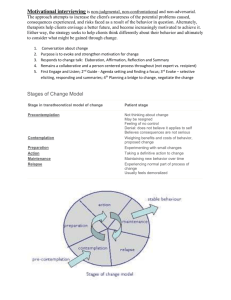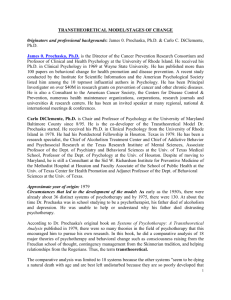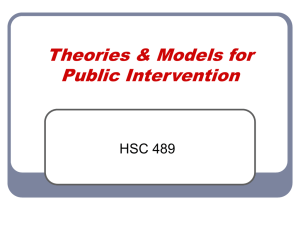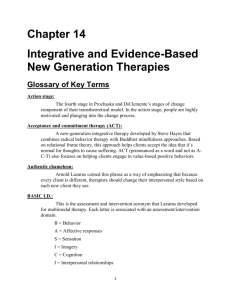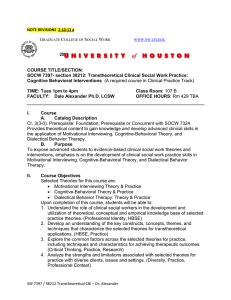C281-H01
advertisement
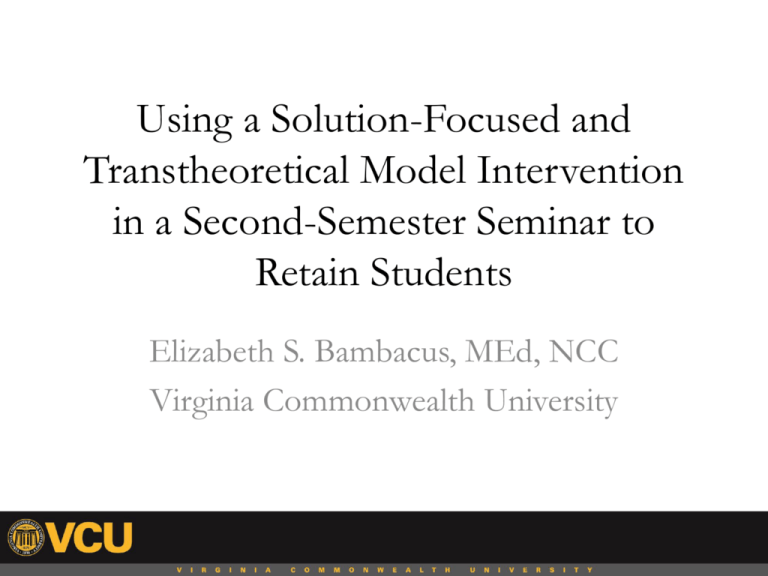
Using a Solution-Focused and Transtheoretical Model Intervention in a Second-Semester Seminar to Retain Students Elizabeth S. Bambacus, MEd, NCC Virginia Commonwealth University The “R” Word Retention Student engagement • E.g., living-learning communities, service-learning Grade point average • First semester/year: significant predictor of graduation (Clarke & Cundiff, 2011; Jamelske, 2008) • First-semester seminars - Effectiveness inconclusive (Hendel, 2007) - Focus here on second semester UNIV 102 • MINDSET for Academic Success (Motivation, Investigation, Navigation, Direction, Study Skills, Expectations, Time Management) • • • • Second-semester first-year seminar Academic warning, murky middle Taught by advisors Problem: engagement and motivation Getting Buy-in • Have students choose their own goal • Have them self-monitor and self-regulate • Use theoretical models – Transtheoretical Model’s Stages of Change – Solution-Focused Therapy Transtheoretical Model: Stages of Change • 18 psychotherapies: shared processes, 5 stages (Prochaska & DiClemente, 1982) • Process: how the person changes • Stages: when the person changes • Processes and stages take time – Early stages = cognitive processes – Late stages = behavioral processes – (Grant & Franklin, 2007) Transtheoretical Model • Abundantly represented in medical (addictions) and athletic fields (Norcross, Krebs, & Prochaska, 2011) • Only two known studies in collegiate setting (Grant & Franklin, 2007; O’Brien, 2002) • Changeology (Norcross, 2012) Stages of Change 1. Precontemplation Person does not realize need for behavior change 2. Contemplation Aware of problem; decides change is needed 3. Planning Thinks about steps necessary for change 4. Action Implements the plan 5. Maintenance After 6 months of success, prevents relapse Stages in College Students (GPA) 1. Precontemplation First-semester even if grades are bad 2. Contemplation End of first semester, during winter break; decide to take 2nd semester orientation course 3. Planning Develop steps for getting better grades 4. Action Spend semester working towards their goal 5. Maintenance Use new skills through rest of college to keep on track Solution-Focused Theory • Constructivism paradigm: Response to lengthy psychotherapies finding root cause of problems (Berg & De Jong, 1996) • Client is the expert • Client defines problem • Client sets goals to overcome problem Solution-Focused Theory • Counselor’s role: – Help client reconstruct perception of reality – Use techniques to highlight client’s strengths • Common techniques – Miracle question – Exception questions – Coping questions – Scaling questions SFT and College Students • Plethora of studies in higher education • Positive outcomes in academic development when using techniques: (Devlin, 2006) – Goal setting – Acknowledging pre-session change – Scaling questions • Few apply SFT approach to freshman orientation courses (Fitch, Marshall & McCarthy, 2012) 90-Day Academic Challenge • Semester-long, goal-oriented series of assignments and activities • Uses SFT and the stages of change • Objectives: – For students to take ownership of academic improvement for continued success – Increase in second-semester GPAs from first semester – Increase in retention rates due to increased GPAs 90-Day Academic Challenge (Reasoning) • Contemplation stage: – Students choose to take the course – Ownership of change begins • Self-monitoring – Subset of self-regulation – Student observes own behavior and determines if it positively or negatively influences academic achievement 90-Day Academic Challenge Action Plan • Planning Stage • Matt Cutt’s (2011) TED Talk “Try Something New for 30 Days” • 18 – 254 days for form a habit (Lally, Van Jaarsveld, Potts & Wardle, 2010) • Students create detailed action plan Choosing a Goal • Student chooses goal – One of the best predictors of academic success (Klomegah, 2007) – Ownership and pride – Main component of both SFT (Devlin, 2006) and transtheoretical model (Norcross, Krebs, & Prochaska, 2011) • Instructor guides student in choosing appropriate goal (SFT) Steps for Achieving the Goal • Student lists detailed small goals toward end goal • SFT technique – builds self-efficacy – More likely to keep working toward main goal (Cheng & Chiou, 2010) • Transtheoretical planning stage – List identifies specific steps needed to achieve change • Be specific: – Do say: “I will study every Monday and Wed from 3-5pm” – Don’t say: “I will study more.” Predicting Challenges • Student lists possible obstacles towards goal – Illness = missed classes – Sleep through a test – Forget deadline for a paper • Student outlines solutions for each challenge – Exchange contact information with other students – Follow up with professor, see academic advisor – Follow up with professor, see academic advisor Support Network Students lists as many resources as they can – Campus resources: Writing Center, Counseling Services, Academic Advising, Library – Other resources: Mother, father, sister, brother, friend, neighbor, RA, professor, advisor – Particularly helpful for first-generation students (Swecker, et al., 2013) Scaling • “On a scale of 1-5, rate your progress on small goals this week; on main goal” (1= little, 5=met) • Help student measure progress (Strong, Pyle & Sutherland, 2009) • Seeing progress is critical to successful selfmonitoring (Zimmerman & Paulsen, 1995) • Weekly scales show improvement over time • Report weekly with journals Weekly Journals • Submit online (Blackboard, Dropbox, etc.) • Weekly reflection discussing accomplishments and disappointments • Scaling ratings reported at end of reflection • Grade on submission, not on progress Role of Instructor • Provides ongoing encouragement and support • Presents academic success skills (e.g., study skills, time management) • Willing to change class topic depending upon immediate needs (disclosed in class or through journals) • Confronts incongruent behavior to help develop selfmonitoring • Provides accountability (e.g., deduct points for missed assignments) Outcome • Overall improvement in academic achievement • Spring 2014: – Students who took the class: • 17 students, 7 of them on academic warning (<2.0) • 58% of all 17 increased GPA • 43% of warning got on good academic standing – Students who did not take the class: • 119 additional students on caseload • 39% increased GPA • None on warning made good academic standing (probation) Additional Observations • • • • Small group discussions Journaling invaluable Scaling hit or miss Requirements were met more after middle of semester • Additional requirements: tutoring and agendas – Difficult to meet – “Changed my life” Limitations • Not all students on academic warning were in the class (from caseload) • Enrollment is optional • Small “sample” • Class meets once a week References Berg, I.K., & De Jong, P. (1996). Solution-building conversations: Coconstructing a sense of competence with clients.” Families in Society: The Journal of Contemporary Social Services, 77(6), 376-391. Clark, M. & Cundiff, N. (2011). Assessing the effectiveness of a college freshman seminar using propensity score adjustments. Research in Higher Education, 52(6), p. 616-639. DeShazer, S. (1985). Keys to Solution in Brief Therapy. Norton: New York. Hendel, D. (2007). Efficacy of participating in a first-year seminar on student satisfaction and retention. Journal of College Student Retention Research Theory and Practice, 8(4). Jamelske, E. (2008). Measuring the impact of a university first-year experience program on student GPA and retention. Higher Education, 57(3), p. 373-391. Grant, A. M., & Franklin, J. (2007). The transtheoretical model and study skills. Behaviour Change, 24(02), 99-113. Klomegah, R. (2007). Predictors of academic performance of university students: an application of the goal efficacy model. College Student Journal, 41(2), 407-415. Kuh, G. D., Cruce, T. M., Shoup, R., Kinzie, J., & Gonyea, R. M. (2008). Unmasking the effects of student engagement on first-year college grades and persistence. The Journal of Higher Education, 79(5), 540-563. Norcross, J.C., Krebs, P.M., & Prochaska, J.O. (2011). Stages of change. Journal of clinical psychology, 67(2), 143-154. Norcross, J.C. (2012). Changeology: 5 Steps to Realizing Your Goals and Resolutions (Vol. 35, No. 6). Simon and Schuster: New York City. O'Brien, W. K. (2002). Applying the transtheoretical model to academic procrastination. Retrieved from ProQuest Information & Learning. Prochaska, J.O., & DiClemente, C. C. (1982). Transtheoretical therapy: Toward a more integrative model of change. Psychotherapy: Theory, Research & Practice, 19(3), 276. Devlin, M. (2006). Solution focused work in individual academic development. International Journal for Academic Development 11(2), pp. 101-110. Fitch, T., Marshall, J., & McCarthy, W. (2012). The effect of solution-focused groups on self-regulated learning. Journal of College Student Development, 53(4), 586-595. Zimmerman, B.J., & Paulsen, A.S. (1995). Self-monitoring during collegiate studying: An invaluable tool for academic self-regulation. New Directions for Teaching and Learning, 63, 13-27. Cutts, Matt. (2011, March). Try Something New For 30 Days [Video file]. Retrieved from http://www.ted.com/talks/matt_cutts_try_something_new_ for_30_days. Lally, P., Van Jaarsveld, C. H., Potts, H. W., & Wardle, J. (2010). How are habits formed: Modelling habit formation in the real world. European Journal of Social Psychology, 40(6), 998-1009. Cheng, P. Y., & Chiou, W. B. (2010). Achievement, attributions, self-efficacy, and goal setting by accounting undergraduates. Psychological Reports, 106(1), 54-64. Strong, T., Pyle, N., & Sutherland, O. (2009). Scaling questions: asking and answering them in counselling, Counselling Psychology Quarterly, 22(2), 171-185. Swecker, H. K., Fifolt, M., & Searby, L. (2013). Academic advising and firstgeneration college students: A quantitative study on student retention. NACADA Journal, 33(1), 46-53. Thank you! Elizabeth S. Bambacus bambacuses@vcu.edu

